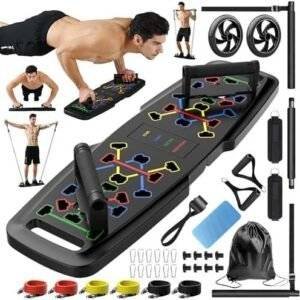As home fitness continues to gain popularity, more individuals are investing in equipment that allows them to maintain their workout routines conveniently and effectively. Among the various options available, the treadmill remains one of the most sought-after pieces of exercise equipment, known for its versatility and ability to accommodate various fitness levels. However, with a plethora of models, features, and price ranges, selecting the ideal treadmill for your home gym can be a daunting task. This essential guide aims to simplify the decision-making process by offering key insights into the critical factors to consider, including space requirements, workout goals, budget constraints, and desired features. By understanding these elements, you will be empowered to choose a treadmill that not only meets your fitness needs but also enhances your overall gym experience. Dive in as we explore the essential criteria for finding the perfect treadmill tailored to your lifestyle.
Table of Contents
- Understanding Your Fitness Goals and Space Requirements
- Key Features to Consider When Choosing a Treadmill
- Evaluating Treadmill Brands and Models for Quality and Durability
- Budgeting for Your Treadmill Investment and Maintenance Needs
- The Conclusion
Understanding Your Fitness Goals and Space Requirements
When embarking on your fitness journey, it’s crucial to clearly define your fitness goals. Consider whether you are aiming to improve cardiovascular endurance, lose weight, build muscle, or simply maintain your overall health. Each goal will influence not only the type of treadmill you choose but also the features that will be most beneficial for your workouts. For instance:
- Weight Loss: Look for treadmills with higher incline options to increase calorie burn.
- Muscle Building: Consider machines with interval training programs that push your limits.
- Endurance Training: A treadmill with extended running time and distance tracking may be essential.
Additionally, assessing your available space is vital when selecting a treadmill. Measure where you plan to place the equipment, considering both footprint and height, especially if you live in a smaller home or apartment. There are various types of treadmills to accommodate diverse space requirements, from compact, foldable models to more robust, non-folding versions. Below is a simplified comparison of popular treadmill types regarding space efficiency:
| Treadmill Type | Dimensions (L x W x H) | Space Requirement |
|---|---|---|
| Foldable | 60″ x 28″ x 50″ | Minimal when stored |
| Non-Foldable | 70″ x 36″ x 55″ | Dedicated space required |
| Compact | 54″ x 24″ x 48″ | Ideal for small areas |
Key Features to Consider When Choosing a Treadmill
When selecting a treadmill, consider the motor power, which directly impacts performance and longevity. A motor rated for at least 2.5 CHP (continuous horse power) is ideal for providing enough power for running without strain. Additionally, the running surface matters; a wider and longer belt is essential for comfort, allowing for a more natural stride. Look for models that offer cushioning features as well, as they can significantly reduce stress on your joints, making workouts more enjoyable and sustainable.
Don’t overlook the console features; ensure the display is user-friendly and offers essential metrics such as speed, track distance, and heart rate monitoring. Connectivity options, like Bluetooth integration, can enhance your workout by enabling music streaming or compatibility with fitness apps. space and storage capabilities are vital for home gyms. Consider foldable models that can be easily tucked away when not in use, while still offering stability and durability during exercise.
Evaluating Treadmill Brands and Models for Quality and Durability
When evaluating treadmill brands and models, it’s essential to focus on factors that contribute to their overall quality and durability. Look for brands with a strong reputation in the fitness industry, as they often invest significantly in research and development. Consider the following features when assessing a treadmill’s quality:
- Frame Construction: A solid steel frame typically indicates better stability and longevity.
- Motor Power: A higher horsepower (HP) rating often translates to a more robust motor that can handle varied workouts.
- Warranty: Longer warranties can hint at a manufacturer’s confidence in their product’s durability.
Different models within a brand can also vary significantly in quality. To streamline your decision-making process, create a comparison table highlighting key specifications and features of top models. Pay attention to:
| Model | Frame Material | Motor HP | Warranty |
|---|---|---|---|
| Brand A Model 1 | Steel | 3.0 | 10 years frame |
| Brand B Model 2 | Aluminum | 2.5 | 7 years frame |
| Brand C Model 3 | Steel | 3.5 | 15 years frame |
Budgeting for Your Treadmill Investment and Maintenance Needs
When investing in a treadmill for your home gym, it’s crucial to consider not only the initial purchase price but also the ongoing maintenance costs. A quality treadmill can range from a few hundred to several thousand dollars, depending on features and brand reputation. Allocate a portion of your budget for essential accessories and services, including:
- Warranty or service plans: Look for options that cover repairs or maintenance for at least a few years.
- Replacement parts: These could include belts, motors, or consoles that may need replacement after heavy use.
- Accessories: Such as lubricants, cleaning kits, or mats to protect your flooring.
Moreover, it’s wise to schedule regular maintenance to prolong the life of your treadmill and keep it running smoothly. Consider the following routine maintenance costs:
| Maintenance Task | Estimated Cost | Frequency |
|---|---|---|
| Belt Lubrication | $15 – $30 | Every 3-6 months |
| General Cleaning | $0 (DIY) | Weekly |
| Motor Inspection | $50 – $120 | Annually |
The Conclusion
As we conclude this essential guide to selecting the ideal treadmill for your home gym, it’s clear that making an informed choice can significantly enhance your fitness journey. By considering factors such as space, budget, features, and personal fitness goals, you can identify a treadmill that not only meets your needs but also inspires you to stay active and engaged. Remember, a treadmill is more than just a piece of equipment; it’s an investment in your health and well-being. Take the time to evaluate your options and conduct thorough research before making a purchase. With the right treadmill, you can create a personal oasis for fitness that motivates you to achieve your goals, regardless of the weather outside. Here’s to making strides toward a healthier, fitter you!





